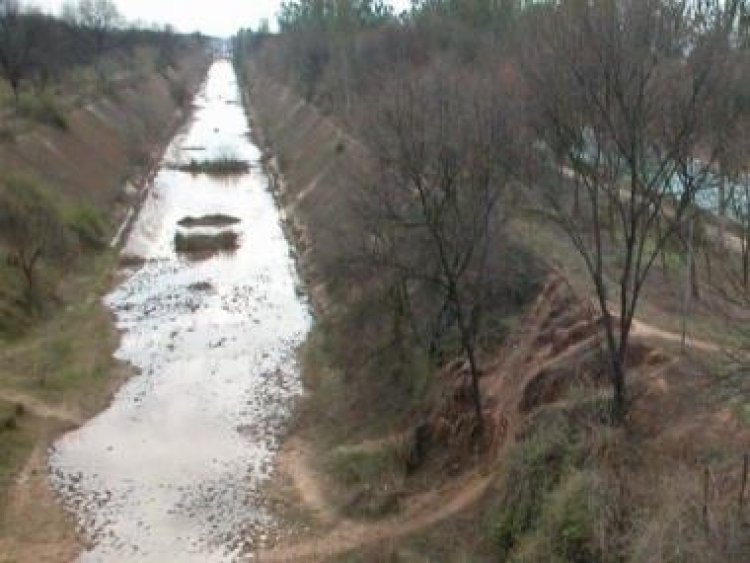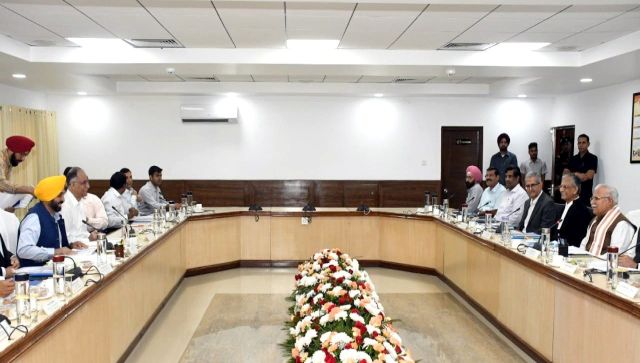Punjab, Haryana chief ministers discuss the Sutlej-Yamuna Link canal: What is the decades-long dispute?
Punjab, Haryana chief ministers discuss the Sutlej-Yamuna Link canal: What is the decades-long dispute?

It’s a dispute between Haryana and Punjab that has been going on for more than fifty years. Now, the Sutlej Yamuna Link (SYL) canal is back in the spotlight as the chief ministers of the two states met.
Bhagwant Mann and Manohar Lal Khattar, the chief ministers of Punjab and Haryana, respectively, discussed the SYL canal issue. The meeting was hosted by Khattar at Haryana Niwas in Chandigarh after the Supreme Court recently nudged the two states to find an amicable solution.
The Haryana CM said in a statement that they would discuss the completion of the construction of the SYL canal and not the contentious issue of sharing of waters. “We will come to sharing of waters later. The meeting is to discuss the construction of SYL,” he said.
#SYL का निर्माण हरियाणा के लिए जीवन मरण का सवाल है। सुप्रीम कोर्ट द्वारा SYL के निर्माण हेतु दिए गए निर्देशानुसार आज हमने पंजाब सरकार के साथ चंडीगढ़ में बैठक की।
पंजाब सरकार इस विषय पर सहमत नहीं हुई, अब हम केंद्रीय मंत्री श्री गजेंद्र शेखावत जी को आज की बैठक के विषय में बताएंगे। pic.twitter.com/TIUAfYJZs5
— Manohar Lal (@mlkhattar) October 14, 2022
What is the SYL canal?
The SYL canal is a proposed 214-kilometre-long canal connecting Sutlej and Yamuna rivers. It was planned in 1966 after the state of Haryana was carved out of Punjab.
While the decision to share resources was taken, the terms on sharing waters of two rivers, Ravi and Beas, were left undecided.
Punjab, however, was against sharing waters of the two rivers with neighbouring Haryana, citing riparian principles, which state that the owner of land adjacent to a water body has the right to use the water, besides arguing that it had no water to spare.
What did the Indian government say about water sharing?
In 1976, a decade after the reorganisation of Punjab, the Centre issued a notification that both states will receive 3.5 million acre-feet (MAF) of water each.
On 31 December 1981, an agreement was made between Punjab, Haryana and Rajasthan to reallocate the waters of Ravi and Beas in “overall national interest and for optimum utilisation of the waters”. A reassessment was done and the water flowing down Beas and Ravi was estimated at 17.17 MAF. Of this, 4.22 MAF was allocated to Punjab, 3.5 MAF to Haryana, and 8.6 MAF to Rajasthan, by agreement of all three states.
On 8 April 1982, then-Prime Minister Indira Gandhi launched the construction of the YSL canal in Kapoori village, Patiala district. The canal was to be 214-kilometre long, of which 122 km was to run across Punjab and 92 km across Haryana.
Punjab’s Shiromani Akali Dal (SAD) was not happy and launched a protest against the construction, the Kapoori Morcha.
In July 1985, then-Prime Minister Rajiv Gandhi met then-SAD chief Harchand Singh Longowal and signed an accord, agreeing to a new tribunal to assess the water. The Eradi Tribunal was set up, headed by Supreme Court Judge V Balakrishna Eradi. In 1987, it recommended an increase in the shares of Punjab and Haryana to 5 MAF and 3.83 MAF, respectively, according to reports.

How did militancy in Punjab make matters worse?
However, Punjab saw a rise in militancy and the construction of the canal became a polarising issue.
Longowal was killed by militants in August 1985, less than a month after signing the accord. In 1990, chief engineer M L Sekhri and a superintending engineer Avtar Singh Aulakh were also killed by militants. Several labourers working on the project were shot dead. In wake of the increasing violence, the construction of the SYL canal was stopped in the 1990s. A large part of it was built, costing over Rs 750 crore, according to News18.com.
What has the Supreme Court said?
In 2002, the Supreme Court (SC) directed Punjab to continue work on the SYL and complete it within a year. The state refused to oblige; instead, it petitioned for a review of the SC order, which was rejected.
In 2004, following orders from the top court, the Central Public Works Department was appointed to take over the canal work from the Punjab government. However, the state continued to remain defiant.
The Punjab Legislative Assembly passed the Punjab Termination of Agreements Act of 2004, which abrogated all its river water agreements with neighbouring states. Then-President Dr APJ Abdul Kalam referred this Bill to the Supreme Court to decide on its legality in the same year, reports The Quint.
The case came up for hearing in the top court in 2016. In November of that year, it said that the Punjab Termination of Agreements Act 2004, was illegal.
However, Punjab decided to denotify 5,376 acres of land that was acquired for the canal and return it to its original owners free of cost.
In February 2017, the SC stuck to its earlier verdict that the construction of the SYL has to be executed and asked Haryana and Punjab to maintain law and order “at any cost”.
What are Punjab’s complaints?
According to a study by the state government, many areas in Punjab will go dry by 2029. The state has already over-exploited its groundwater for irrigation purposes as it fills granaries of the Centre by growing wheat and paddy worth Rs 70,000 crore every year, reports The Indian Express.
Punjab maintains that it is not in a position to share water as the situation is dire.
In July 2004, the Punjab Assembly enacted the Punjab Termination of Agreement Act, annulling all inter-state agreements signed by the state relating to sharing of Ravi and Beas waters.
What is Haryana saying?
Haryana believes it has been denied its rightful share of water. It says that providing irrigation is tough for the state. There was a problem with drinking water in southern parts of Haryana, where groundwater has depleted up to 1,700 feet, the newspaper reports.
In April, Khattar moved a resolution urging the Centre to take measures for the construction of the SYL canal.
“The right of Haryana to share waters Ravi and Beas rivers by the construction of the SYL Canal is historically, legally, judicially and constitutionally established over time. The august House has unanimously on at least seven occasions passed resolutions urging the early completion of the SYL canal,” the resolution read.
Is there a solution in sight?
Haryana had told the Supreme Court last month that the chief ministers of Punjab were reluctant to hold meetings on the matter. It stated that the Harayan CM had written a letter to Mann in April but received no response.
The Centre had on 6 September informed the SC that the Punjab government was “not cooperating” in resolving the dispute.
Then-Attorney General K K Venugopal, appearing for the Centre, had told the bench that the top court had in 2017 called for an amicable settlement and that it was trying to bring the two states on the same page through its Water Resources Ministry. “Unfortunately, Punjab has not been cooperating,” the top law officer had said.
The counsel for Punjab had last month told a bench headed by Justice S K Kaul that the state government was very keen to resolve the issue amicably.
But leaders from the state have urged Mann to stick to his ground on water sharing, making it clear that the state “has not a drop extra to spare”.
SYL ਦੇ ਮਸਲੇ ‘ਤੇ ਪੰਜਾਬ-ਹਰਿਆਣੇ ਦੀ ਮੀਟਿੰਗ ਤੋਂ ਬਾਅਦ ਮੀਡੀਆ ਦੇ ਸਾਥੀਆਂ ਨੂੰ ਜਾਣਕਾਰੀ…Live https://t.co/HE7AWZZqzm
— Bhagwant Mann (@BhagwantMann) October 14, 2022
“Punjab’s water will remain with us. We will not allow any water to flow to Haryana. CM Mann will take up the issue with his Haryana counterpart strongly,” said Punjab Finance Minister Harpal Singh Cheema, reports The Indian Express.
Congress’ Partap Bajwa, Leader of the Opposition, threatened to sit on a dharna if the canal is constructed. “The chief minister should say that we would not allow a brick on the SYL and not even a drop to flow from Punjab,” he said.
With inputs from agencies
Read all the Latest News, Trending News, Cricket News, Bollywood News,
India News and Entertainment News here. Follow us on Facebook, Twitter and Instagram.
What's Your Reaction?


























































